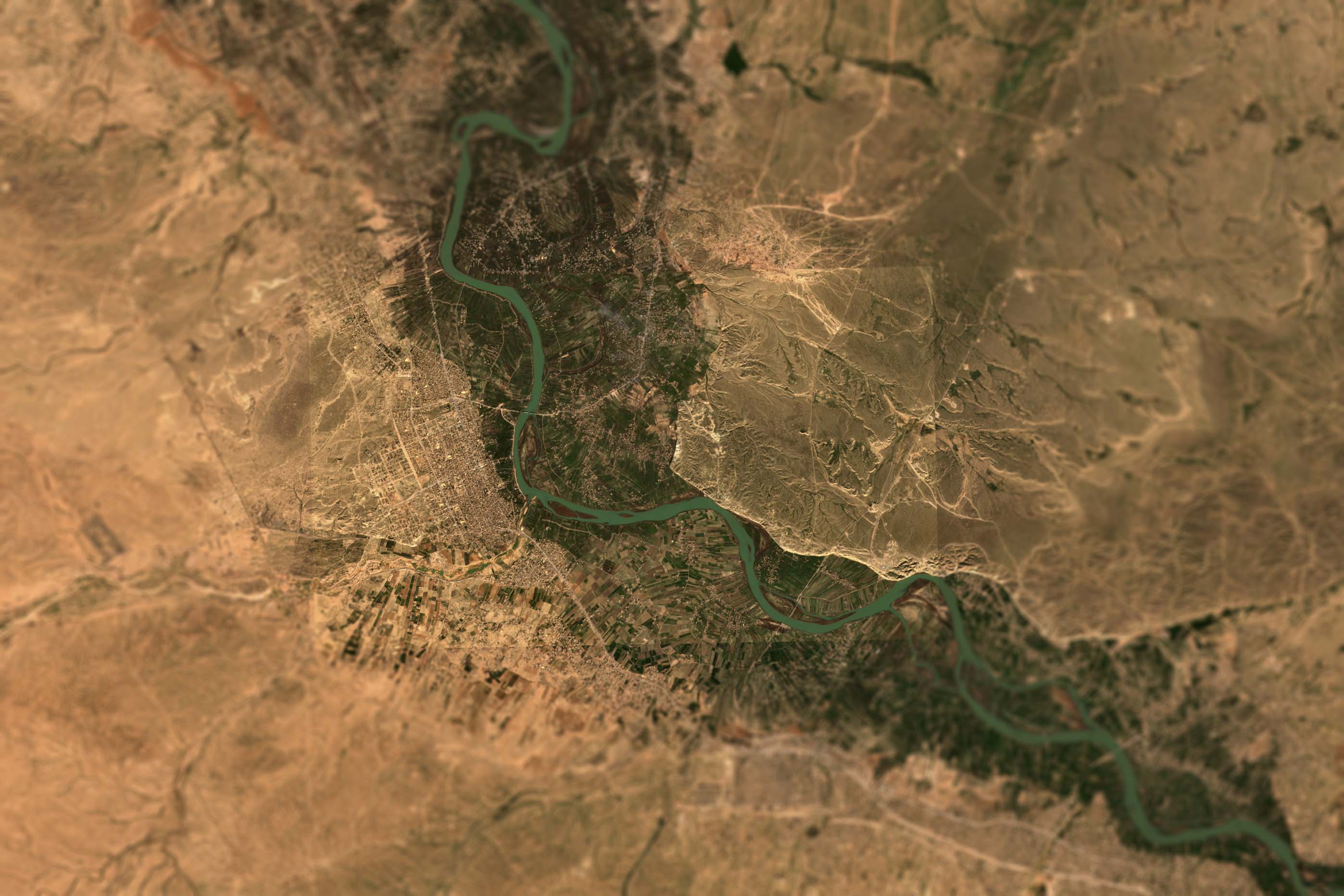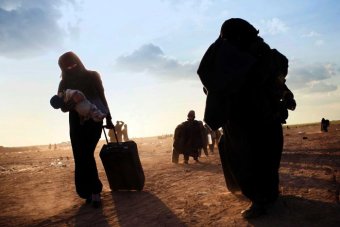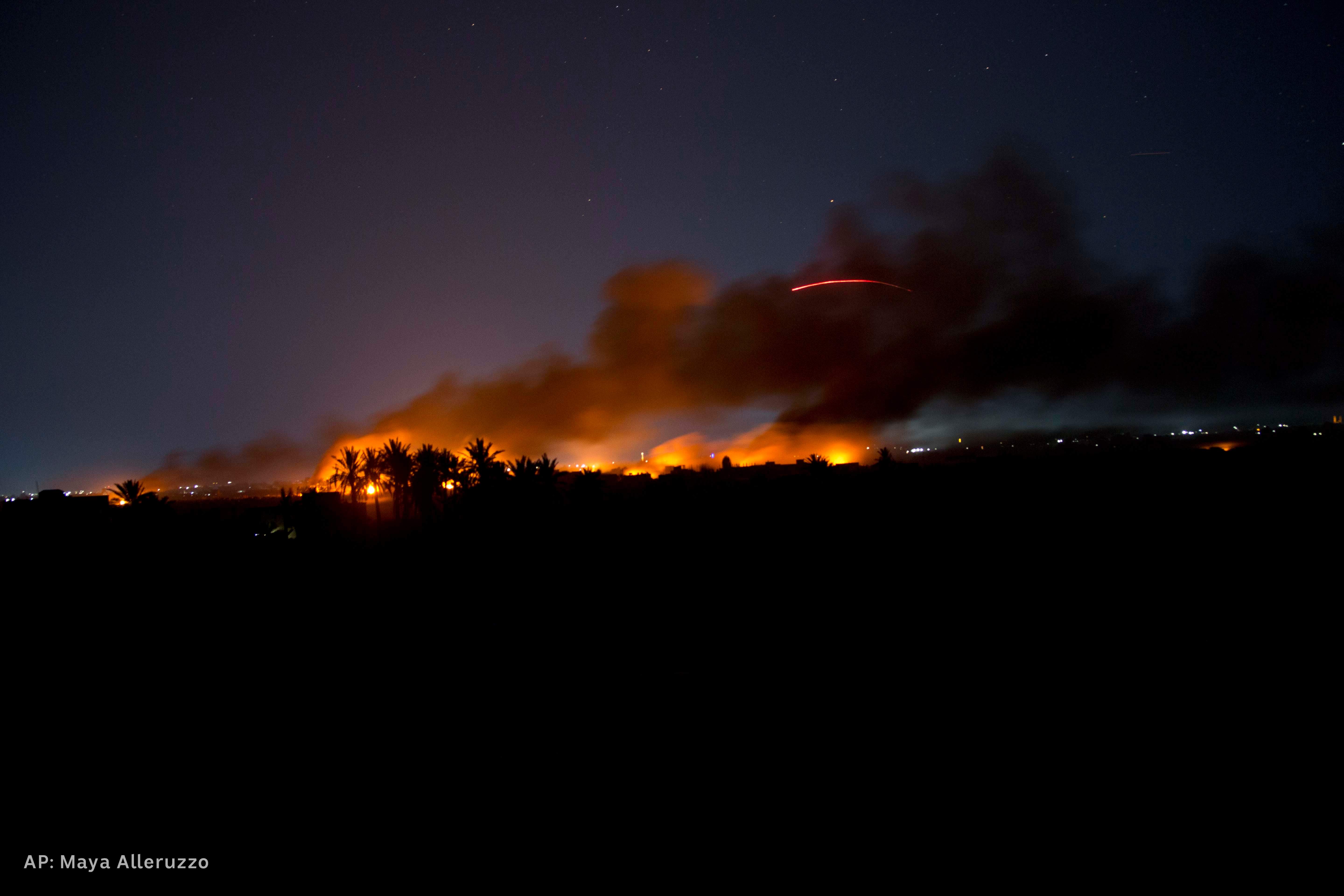Inside the fiery battle to retake Islamic State's final pocket of territory in Baghouz, Syria
Updated
In the final surge of the battle against Islamic State in Syria, all that remained of the terrorist group's once vast caliphate was a squalid, makeshift camp on the banks of the Euphrates River.
The tiny holdout in Baghouz, sandwiched between the cliffs and the Iraqi border to the east and the river to the west and south, was a far cry from the tens of thousands of kilometres of territory IS once held across Iraq and Syria.
Using satellite imagery from the area, reporting from the ground and the vast amounts of content posted to social media from the region by forces opposed to the terrorist group, we've pieced together the fierce and complex battle to reclaim the final sliver of land from IS in Iraq and Syria.
As you wind your way down the Euphrates River in eastern Syria near the Iraqi border, the signs of Islamic State's brutal occupation are everywhere.
In Hajin, all that remains are bombed-out ruins. Suicide bombers' cars blown in half, sandbagged positions in windows, blown-apart bunkers.
Village after village, it's a similar story. As opposition forces advanced, the terrorist group was forced to flee to another town further down the Euphrates corridor.
Many buildings are pancaked flat from direct hits by US bombs.
Even the roads are destroyed. The drive between these IS strongholds requires a detour every 500 metres or so around enormous bomb craters, three or four metres deep, some filled with the wreckage of cars or motorbikes.
Eventually, the path of destruction ends here in the town of Baghouz, where, by January, thousands of jihadists were surrounded by opposition forces.

This was the final Islamic State stronghold.
By early February, a relentless ground and air assault was centred on the built-up areas of Baghouz.

From the sky, these battle scars can be seen littered across the village. This imagery was captured on February 19.
An analysis by Human Rights Watch identified 630 "major damage sites... consistent with the detonation of large, air-dropped munitions" in one month between January 19 and Feb 20.
The bombardment sparked a mass exodus from Baghouz. Those on the ground fled with little more than the clothes on their back as mortars rained down.
The most hardline jihadists moved out of the built-up areas and south towards the banks of the Euphrates River.
The changes in the landscape as this occurs are visible in satellite imagery. Satellite video captured by Planet Labs Inc. on February 22 shows how busy the area had become.

Tens of thousands of people — both surrendering IS members, their victims and civilians — began fleeing into the desert towards areas controlled by US-backed Kurdish forces. Among those surrendering were foreigners from countries including Australia and New Zealand.
Many arrived at this screening point about 10 kilometres north of Baghouz in the desert — a desolate expanse of hard-packed dirt with no shelter from the rain or cold desert winds.
Iraqi woman Sanaa Mohammad, from Fallujah, arrived there with four children in tow. It would have been five but she said her baby boy Hassan died two weeks ago because there was no milk or medicine.
She said the children had been forced to eat grass for two months because there was no food.
At the screening point, women and children like Sanaa Mohammad and her family were searched for weapons before being allowed to move with their bags to another area about 500 metres away. Here they waited for transport to refugee camps hours to the north.
As they waited to be called onto a truck, they huddled under blankets in the desert. The children were filthy and starving, and their cries could be heard as soon as you opened your car door. More than 100 people died on the way to the camp or soon after arriving, most of them children.
All the men and many women considered of value to intelligence were separated from the main group of refugees and handed over to Western special forces for processing and questioning. Iraqi IS suspects may be handed back to Iraq, where they will face trial and most likely be executed.
Stunned by the number of people streaming out of Baghouz, Kurdish forces arranged a ceasefire of sorts to allow civilians and IS supporters to hand themselves over and escape the fighting.
By early March, the flow of people had eased and intense fighting resumed.

Kurdish forces estimated there were still thousands of jihadists still left in the camp.
This image taken by a drone and released in an IS propaganda video also shows a populated, busy area.
This is the same location captured by satellite at an earlier date.

By night, remaining fighters were slammed from the air.
By day, Kurdish forces on the ground advanced metre by metre into the camp, pushing the remaining IS fighters towards the cliffs to the east.
Each day, SDF forces took more territory from IS, but their advance was slowed by sniper fire, suicide bomb attacks and the threat of landmines.
By March 19, all that remained of Islamic State's so-called caliphate was this tiny pocket of land in the reeds of the Euphrates River. Days later, the SDF announced it had retaken Baghouz and that around 5,000 Islamic State fighters had surrendered over the course of the battle.
It was a slow end to a five-year war to dismantle the terrorist group's pseudo-state which once covered an area around the size of Britain across Syria and Iraq.
Imagery: EU/Sentinel 2
Imagery: Planet Labs Inc
The battle was a milestone in the fight against IS. The pseudo-state, declared by the group's leader Abu Bakr al-Baghdadi in 2014, has all but been dismantled.
But it is not the end of the terrorist group.
Many of the women interviewed after escaping Baghouz remained loyal to Islamic State. They were angry the caliphate was over and were determined to bring it back and see it rise again.
On top of that, the terrorist group maintains strong support in parts of Iraq and Syria and the fighters conduct regular terrorist attacks and executions.
In January alone, while IS fighters were facing territorial defeat, data shows the terrorist group remained active across large parts the Iraq and Syria. Abu Bakr al-Baghdadi remains at large and, further abroad, cells continue to operate.
General Joseph Votel, head of the United States Central Command, told a Senate committee in February that IS could stage a resurgence.
"Hard-won battlefield gains can only be secured by maintaining a vigilant offensive against a now largely dispersed and disaggregated ISIS that retains leaders, fighters, facilitators, resources and the profane ideology that fuels their efforts," he said.
"It's important to understand that even though this territory has been reclaimed, the fight against ISIS and violent extremists is not over and our mission has not changed."
Additional credits:
Development: Ri Liu and Nathanael Scott
Topics: terrorism, unrest-conflict-and-war, defence-and-national-security, syrian-arab-republic, iraq, australia
First posted


















